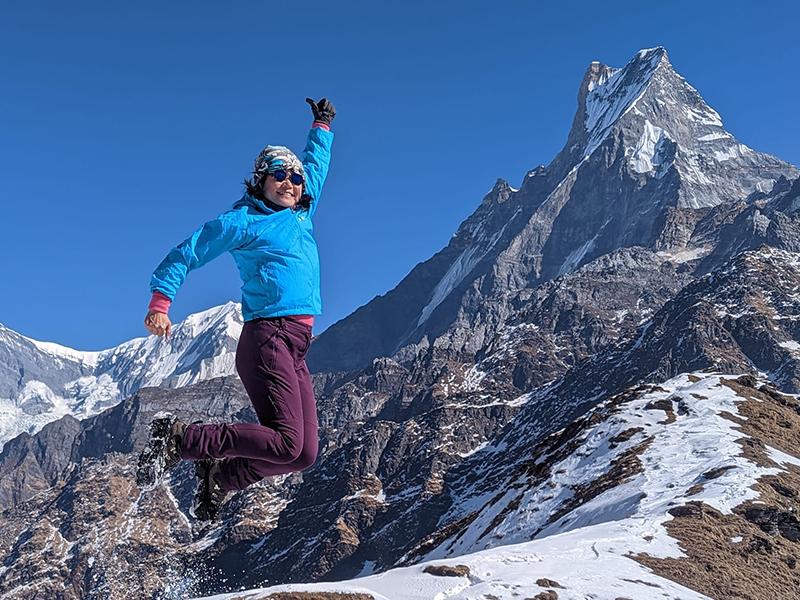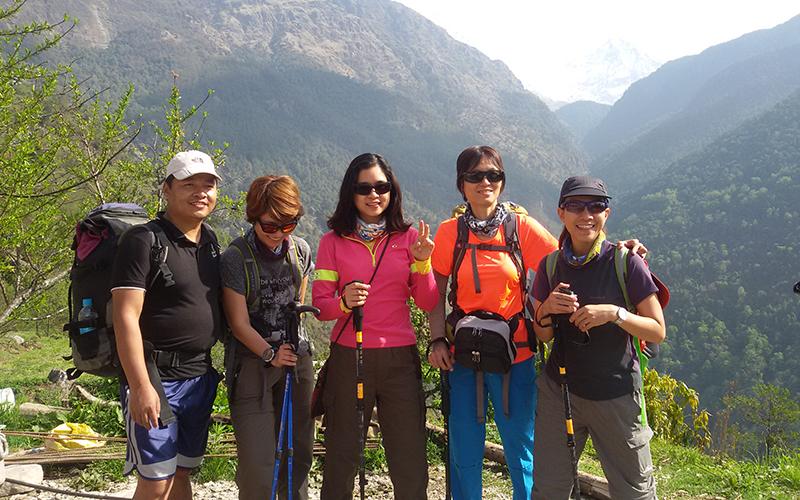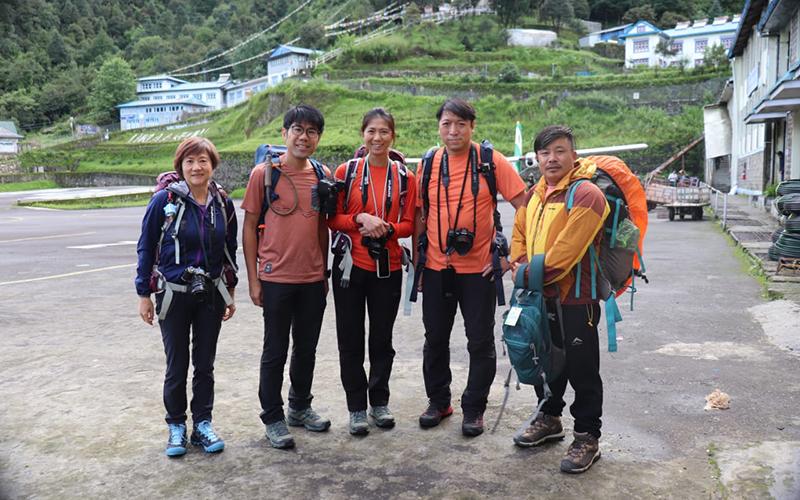Annapurna Base Camp Trek Guide

The Annapurna Base Camp Trek guide Completed, also known as the ABC trek, is a moderate to difficult level trek that takes you to the base of the 10th highest mountain in the world, Annapurna. The trek starts from Nayapul and takes you through the beautiful villages of Ghandruk, Chomrong, Dovan, and Deurali before reaching the base camp. The trek is about 110 km long and takes around 7-12 days depending on the route you choose and your fitness level.
The ABC trek is a popular trekking destination in Nepal, attracting thousands of trekkers every year. The trail offers breathtaking views of the Annapurna massif, including peaks such as Annapurna South, Annapurna I, Hiunchuli, and Machhapuchhre. Along the way, you’ll encounter diverse landscapes, ranging from lush forests to barren high-altitude terrain. The trek also gives you the opportunity to experience the local culture and traditions of the Gurung and Magar communities.

Best time to visit Annapurna Base Camp
The best time to visit Annapurna Base Camp is during the spring (March to May) and autumn (September to November) seasons. During these months, the weather is clear, and the skies are blue, making the trekking experience more enjoyable. The temperature is also moderate, making it easier to trek at higher altitudes.
In the spring, you’ll be able to witness the blooming of rhododendron flowers, adding a vibrant touch to the already stunning landscapes. Autumn, on the other hand, offers clear views of the mountains, with less chance of rain or snow. However, as these are peak seasons, the trails can be crowded, and accommodation costs may be higher.
If you’re looking for a less crowded trekking experience, you can consider visiting during the winter (December to February) or monsoon (June to August) seasons. While the winter season can be challenging due to snowfall and low temperatures, the views are still breathtaking. The monsoon season, on the other hand, brings heavy rainfall, making the trails muddy and slippery. However, the landscapes are lush green, and the valleys come alive with waterfalls and streams.
Annapurna Base Camp Trek: Difficulty level
The Annapurna Base Camp Trek is a moderate to difficult level trek, with altitudes ranging from 1,070 m to 4,130 m. The trail includes steep ascents and descents, rocky terrain, and narrow paths, making it a physically demanding trek.
However, with proper preparation and training, anyone with a good level of fitness and stamina can complete the trek. It’s recommended to start preparing for the trek at least a few months in advance, with a focus on cardio exercises and strength training. It’s also important to acclimatize properly, taking rest days and drinking plenty of fluids to avoid altitude sickness.
If you’re a beginner, it’s recommended to hire a guide or join a trekking group to ensure your safety and make the most of your experience. The guides have knowledge of the trail and can provide valuable insights into the local culture and traditions.
The Annapurna Base Camp Trek has multiple routes that you can choose from, depending on your preference and time availability. The most common route is the Nayapul to Annapurna Base Camp route, which takes you through the villages of Ghandruk, Chomrong, Dovan, and Deurali. This route is around 110 km long and takes around 7-12 days to complete.
Another popular route is the Ghorepani Poon Hill Trek, which offers stunning views of the Annapurna and Dhaulagiri massifs. This route is around 50 km long and takes around 5-7 days to complete. The trek starts from Nayapul and takes you through the villages of Tikhedhunga, Ghorepani, Tadapani, and Ghandruk.
There are also other routes, such as the Annapurna Circuit Trek and the Mardi Himal Trek, which are longer and more challenging. It’s important to choose the route that suits your fitness level and time availability.
Before starting the trek, it’s recommended to get a detailed map of the route and have a basic understanding of the trail. You can get the map from local trekking agencies or online sources. It’s also important to carry a GPS device or a smartphone with GPS capabilities to avoid getting lost.
Annapurna Base Camp Trek: Preparation and Packing List
Proper preparation and packing are crucial for a successful trekking experience. Here’s a checklist of items that you should consider packing for the Annapurna Base Camp Trek:
- Trekking boots: A good pair of trekking boots with ankle support and a sturdy sole is essential for rocky and uneven terrain.
- Clothing: Layered clothing is recommended, including a thermal base layer, fleece jacket, and waterproof jacket. Don’t forget to pack a warm hat, gloves, and a scarf.
- Backpack: A good quality backpack with a capacity of at least 50 liters is recommended to carry your essentials.
- Sleeping bag: A good quality sleeping bag rated for sub-zero temperatures is essential for a comfortable night’s sleep.
- Trekking poles: Trekking poles can help reduce the impact on your knees and provide stability on rocky terrain.
- Water bottle: A reusable water bottle with a capacity of at least 2 liters is recommended to stay hydrated throughout the trek.
- Snacks: High-energy snacks such as trail mix, energy bars, and chocolate can help keep your energy levels up during the trek.
- First aid kit: A basic first aid kit with essentials such as bandages, antiseptic cream, and painkillers is recommended.
- Toiletries: Pack essentials such as toothbrushes, toothpaste, wet wipes, and hand sanitizer.
Annapurna Base Camp Trek: Cost and Budget
The cost of the Annapurna Base Camp Trek can vary depending on your preferences and budget. Here’s a breakdown of the costs involved:
– Trekking permits: You’ll need to obtain two permits, the TIMS (Trekkers’ Information Management System) card and the Annapurna Conservation Area Permit (ACAP). The cost of the permits is around USD 30-35 per person.
– Guide and porter: Hiring a guide and porter is recommended for a safe and hassle-free trekking experience. The cost of hiring a guide is around USD 25-30 per day, and the cost of hiring a porter is around USD 20-25 per day.
– Accommodation and food: Accommodation and food costs can vary depending on the type of accommodation you choose. Basic teahouses can cost around USD 5-10 per night, while more luxurious lodges can cost around USD 30-50 per night. Food costs can range from USD 5-10 per meal.
– Miscellaneous expenses: Miscellaneous expenses such as transportation, equipment rental, and tips can add up to around USD 100-150.
It’s important to budget for unexpected expenses and carry extra cash or a credit card.
Annapurna Base Camp Trek: Accommodation and Food
Accommodation and food options along the Annapurna Base Camp Trek are basic but comfortable. The teahouses or lodges offer basic facilities such as a bed, blankets, and a shared bathroom. Some teahouses also offer hot showers for an additional cost.
The food options are mostly Nepali and Indian cuisine, with options such as dal bhat (rice and lentils), momos (dumplings), and chapati (flatbread). Vegetarian and non-vegetarian options are available. It’s recommended to avoid meat dishes to avoid the risk of food poisoning.
It’s important to carry water purification tablets or a water filter to avoid buying bottled water, which can contribute to plastic waste.
Annapurna Base Camp Trek: Safety and Health
Safety and health are crucial for a successful trekking experience. Here are some tips to stay safe and healthy:
– Acclimatize properly: Take rest days and drink plenty of fluids to avoid altitude sickness.
– Stay hydrated: Drink at least 3-4 liters of water daily to stay hydrated.
– Follow the trail: Stick to the designated trail and avoid shortcuts to avoid getting lost.
– Dress appropriately: Wear layered clothing to adapt to the changing weather and avoid hypothermia.
– Carry a first aid kit: Carry a basic first aid kit with essentials such as bandages, antiseptic cream, and painkillers.
– Avoid alcohol and smoking: Alcohol and smoking can increase the risk of altitude sickness and dehydration.
Annapurna Base Camp Trek: Highlights and Attractions
The Annapurna Base Camp Trek offers a range of highlights and attractions that make it a must-do trekking destination. Here are some of the highlights:
– Hot springs at Jhinu Danda: A relaxing soak in the natural hot springs is the perfect way to rejuvenate after a long day of trekking.
– Panoramic viewpoint at Poon Hill: The sunrise views from Poon Hill are breathtaking, with panoramic views of the Annapurna and Dhaulagiri massifs.
– Annapurna Base Camp: The ultimate destination of the trek, the Annapurna Base Camp offers stunning views of the Annapurna massif, including peaks such as Annapurna South, Annapurna I, Hiunchuli, and Machhapuchhre.
– Local culture and traditions: The trek offers the opportunity to experience the local culture and traditions of the Gurung and Magar communities.
Annapurna Base Camp Trek: Tips and Tricks
Here are some additional tips and tricks to make the most of your Annapurna Base Camp Trek:
– Start training at least a few months in advance with a focus on cardio exercises and strength training.
– Carry a portable charger or power bank to keep your electronic devices charged.
– Pack a book or a deck of cards to keep yourself entertained during rest days.
– Learn some basic Nepali phrases to communicate with the locals.
– Carry enough cash or a credit card, as there are no ATMs along the trekking route.







